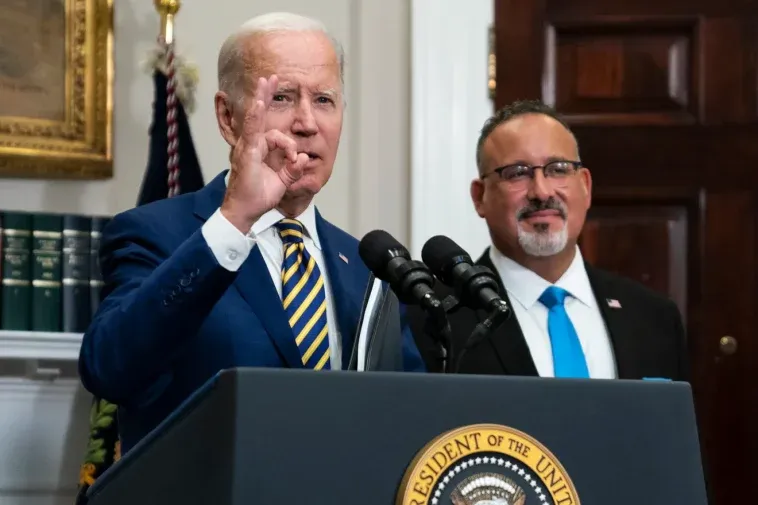(USA Today) With Thanksgiving behind us, we’ve officially entered the Christmas season. It’s a time of year when many of us feel magnanimous.
‘Tis the season for giving, after all.
President Joe Biden is certainly getting in the holiday spirit. He’s feeling very generous – with your money.
After the U.S. Supreme Court in June struck down his unilateral attempt to “forgive” at least $400 billion in student loans, Biden has diligently sought ways to work around this serious reprimand.
He has landed on at least one option that is more costly than his original plan – and will be more difficult to challenge legally.
The millions of Americans who have already paid off their loans or have opted to forgo college altogether may find this development irksome.

Biden has already done enough damage with his failed loan cancellation plan and other meddling. This fall, borrowers finally had to start repaying student loans, with interest, for the first time since the Trump administration paused payments because of COVID-19. That pause alone cost taxpayers more than $200 billion. The Biden administration kept extending the COVID-related payment pause to the point that many borrowers now face confusion about how much they owe and why they even have to pay back loans they took out.
It doesn’t help that Democrats like U.S. Rep. Ro Khanna of California are making idiotic comments about how any confusion over the restart of payments should translate into canceling student debt “for everyone up to $50,000 immediately.”
2/3rds of student loan borrowers say they didn’t know their payments were restarting after a 3.5-year pause. Over 2 million report that they never received a bill or received it with short notice. We need to get this right and cancel student debt for everyone up to $50,000…
— Ro Khanna (@RoKhanna) November 7, 2023
Biden’s ‘sneaky’ new scheme
Since his magic-wand approach to debt cancellation fizzled, Biden has a Plan B. He’s desperate to offer some sort of major loan forgiveness ahead of the next presidential election.
NPR dubbed this the “sneaky other student loan forgiveness plan that is still alive and will affect millions of Americans.”
At the president’s direction, the Education Department took to the rulemaking process to beef up its income-driven repayment plans, which have existed in more limited form for decades. The new regulations took effect this summer, and 5.5 million borrowers have already applied for the program.
Biden’s new student loan scheme: Supreme Court put kibosh on loan forgiveness. That’s not deterred the president one bit.
The department claims it has the authority to expand income-driven repayment under the Higher Education Act.
It’s highly doubtful, however, that Congress ever intended to give the Biden administration blanket authority to create a brand new entitlement program. That’s what this is.
And unlike the one-time debt forgiveness Biden attempted before, this plan is permanent.
SAVE program will cost us
The so-called Saving on a Valuable Education (SAVE) program broadens caps on monthly payments based on income and family size and also offers interest subsidies. Many borrowers won’t have to pay anything each month. Others will qualify for loan forgiveness on remaining balances much more quickly.
The White House has called its program the “most affordable student repayment plan ever.”
But affordable for whom?
These debts don’t magically disappear. While individual borrowers may feel relief, it’s taxpayers who are ultimately left covering the cost. And this new de facto forgiveness plan will add to our ever-growing national debt, which the country can’t afford.
Biden should care about national debt: Another House speaker, another stopgap bill. All the while our national debt explodes.
According to the Penn Wharton Budget Model, Biden’s SAVE plan will cost $475 billion over 10 years.
Other estimates are even higher. The House Committee on Education & the Workforce has stated it could cost as much as $559 billion, which would make it “the costliest regulation in U.S. history.”
Can Biden be stopped? Good luck.
Nat Malkus, deputy director of education policy studies at the American Enterprise Institute, observed in The Wall Street Journal that these changes take income-driven repayment plans “from a safety net for a few to a hybrid loan-grant system that Congress never intended to create.”
Malkus also points to the unintended consequences that are likely, from colleges raising tuition to students taking on even more debt (and thus further burdening taxpayers).
Any kind of widespread loan forgiveness serves as a mask to the underlying reasons higher education is so costly to begin with. It’s also going to make the problem worse.
But what can be done about it?






